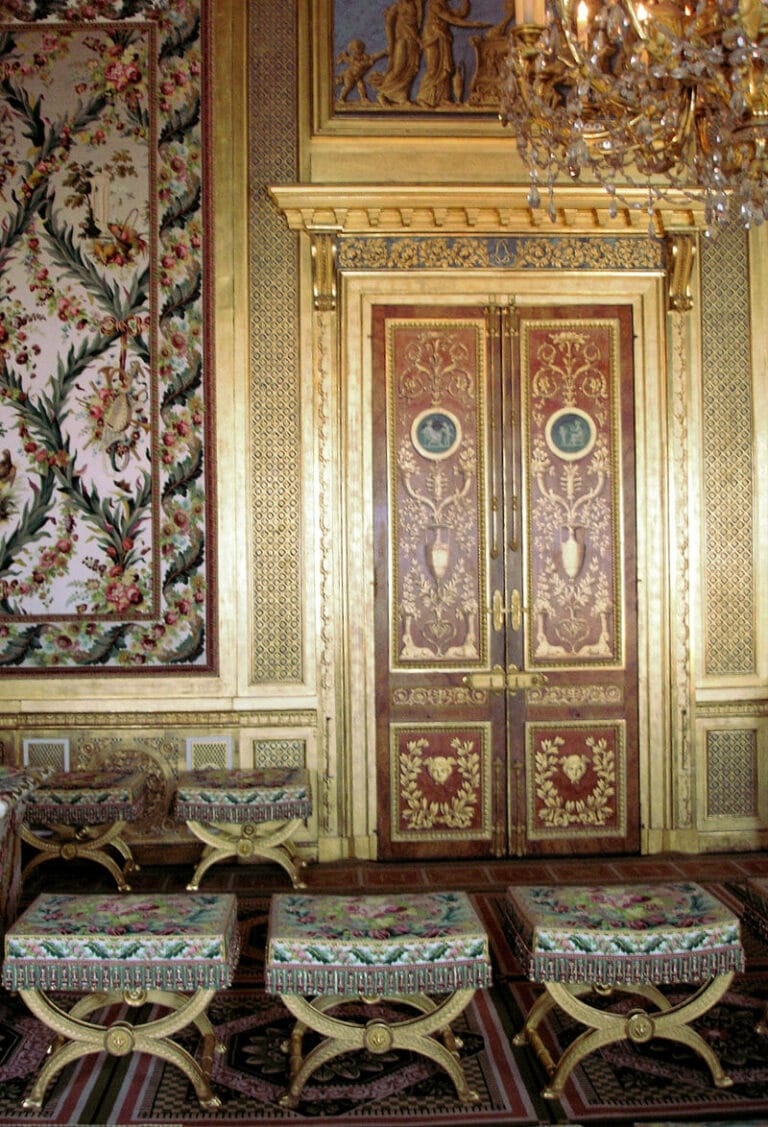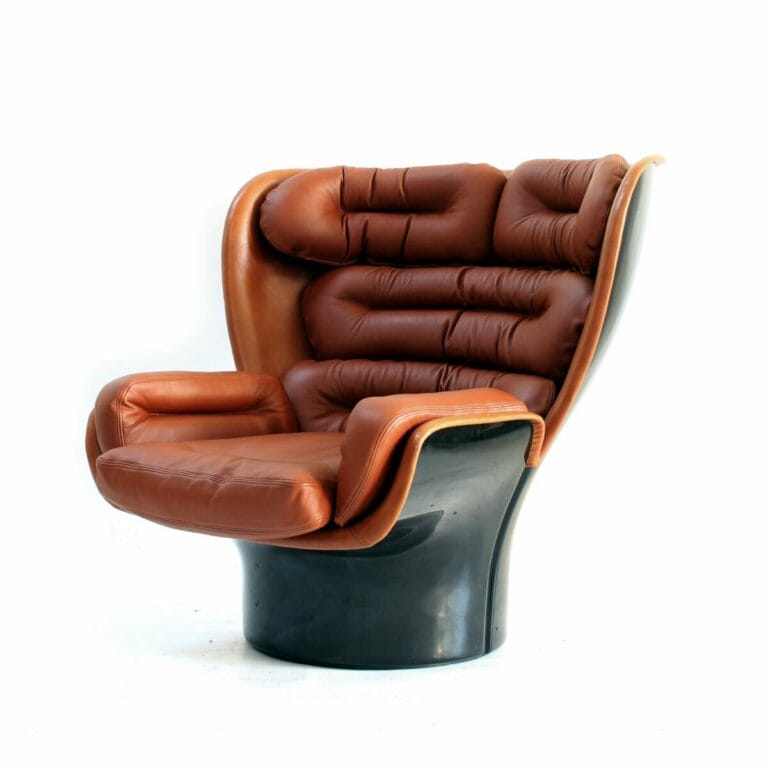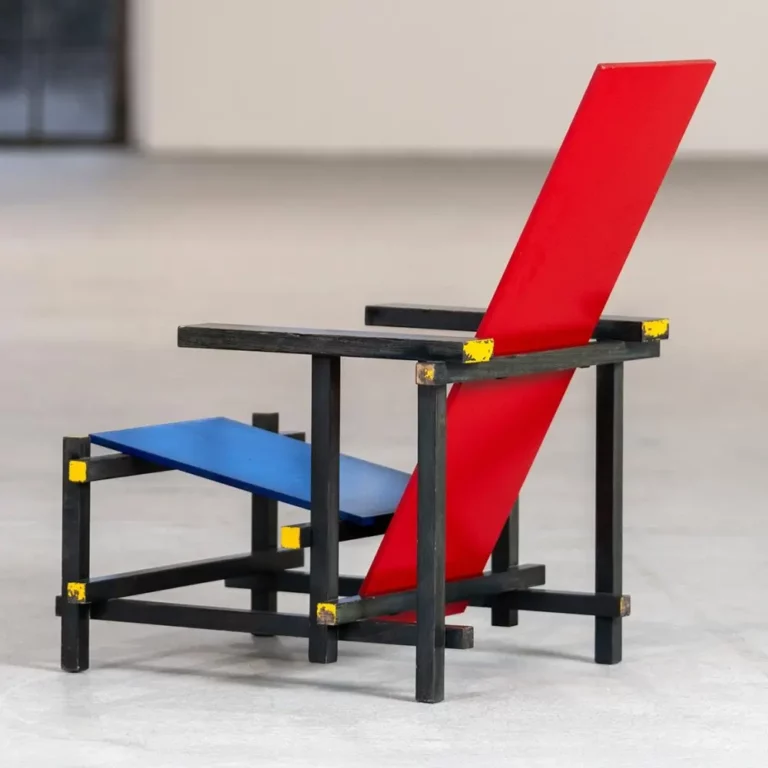Between the oil shocks of the 1970s and the technological euphoria of the late 1980s, an aesthetic revolution transformed architecture and design: the High-Tech movement elevated technology into a creative manifesto. Far from concealing pipes, wiring, or metal structures behind decorative cladding, this radical avant-garde proudly exposed them, transforming infrastructure into ornament and technical performance into visual language. What was once relegated backstage – elevators, ventilation ducts, steel scaffolding – became the raw material of a new industrial beauty
Genesis of an Industrial Aesthetic: The Roots of High-Tech
This celebration of technology as artistic expression emerged from a context of profound transformations: the energy crisis imposed reflection on building efficiency, computing began its conquest of the general public, and a generation of creators trained in the 1960s rejected postmodern ornamentation in favor of radical structural honesty. Architects like Norman Foster, Renzo Piano and Richard Rogers, industrial designers like Mario Bellini, Richard Sapper and Dieter Rams forged an aesthetic vocabulary where the machine inspires art, where the factory becomes cathedral, and where the bolted replaces the sculpted.
Revisited Modernist Heritage
While the High-Tech movement truly emerged in the 1970s, its roots plunge deep into the heritage of European modernism and the functionalist architecture of the interwar period. The precepts of Le Corbusier proclaiming “the house is a machine for living,” the structural experiments of the Bauhaus, and the research on new materials by Jean Prouvé constitute the fertile ground where this new aesthetic germinated. However, where modernists sought a formal purity often white and abstract, High-Tech fully embraced the raw materiality of industry.
British architect Cedric Price, an often-overlooked prophetic figure, laid the theoretical foundations of the movement as early as the 1960s with his visionary project of the Fun Palace (1961) – never built but infinitely influential. This “anti-cathedral of pleasure” conceived with choreographer Joan Littlewood imagined a fully modular metal structure where spaces reconfigured according to uses, where technique no longer served a fixed form but became the instrument of radical flexibility. This conception of the building as an evolving system rather than a finished monument irrigates all High-Tech thinking.
The Archigram group, a collective of British architects formed in 1961 around Peter Cook, Warren Chalk and Ron Herron, pushed this logic to the extreme with spectacular graphic projects like Plug-in City (1964) or Walking City (1964) – mobile, connectable, transformable megastructures fantasizing a nomadic and technological architecture. Although remaining as provocative drawings, these projects installed in the collective imagination the idea of a possible beauty of the machine, a poetry of cranes and containers, prefiguring the High-Tech aesthetic that would be embodied in concrete realizations.
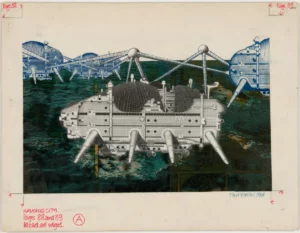
The Economic and Cultural Context of the 1970s
The emergence of High-Tech coincided with a period of economic and social upheavals that redefined the relationship with technology and industry. The oil shocks of 1973 and 1979 imposed urgent reflection on energy efficiency and the thermal performance of buildings. High-Tech architects responded to this challenge with visible technical solutions: high-performance glazing with solar control, natural ventilation assisted by visible mechanical systems, lightweight structures minimizing materials. The crisis thus became an accelerator of innovation rather than a constraint.
Simultaneously, the progressive deindustrialization of Europe and North America transformed the perspective on factories. What was a symbol of worker alienation became, with distance, an object of aesthetic fascination. Disused industrial hangars, abandoned port cranes, obsolete railway infrastructure acquired unexpected heritage value.
High-Tech architects not only built in an industrial style, they rehabilitated and valorized industrial heritage, anticipating the conversions of brownfields into lofts and cultural spaces that would characterize subsequent decades.
Culturally, the emergence of punk in London in 1976-1977, with its DIY aesthetic, safety pins and celebration of the unfinished, shared with High-Tech architecture a fascination for raw and unpolished beauty.
This convergence was not coincidental: it testified to a generation simultaneously rejecting the political establishment, bourgeois comfort and decorative ornamentation in favor of radical authenticity, whether musical or architectural. This formal rebellion was part of a broader context of challenging aesthetic conventions, as also evidenced by the Italian Radical Design movement which, by other means, questioned the dogmas of established design.
Built Manifestos: Technological Cathedrals
Centre Pompidou: Parisian Revolution
When the Centre national d’art et de culture Georges-Pompidou opened its doors in 1977 in the heart of old Paris, the astonishment was general. This “oil refinery” as its detractors called it, this “metallic monster” that dared display its colored entrails facing slate roofs and Haussmannian facades, embodied the High-Tech revolution alone. Designed by young architects Renzo Piano (34 years old) and Richard Rogers (38 years old), winners of an international competition in 1971, the building radically inverted architectural conventions.
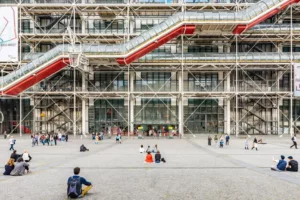
The founding principle consisted of a spectacular inversion: externalize all technical elements – structure, circulation, fluids – to free entirely flexible and modular floors inside. The steel gerberette beams supporting the floors, the transparent escalators on the facade, the blue ventilation ducts, green water pipes, yellow electrical cables and red elevators compose a functional polychromy where each color codes a technical system. This legibility of functions transforms the building into a pedagogical machine that reveals its own functioning.
The initial reception was tumultuous: Pompidou himself, who would not see the project’s completion, was reportedly disappointed by its brutality; Parisians nicknamed it “Notre-Dame of Plumbing” or “the tanker of the Marais.” Yet, with over 7 million visitors in the first year, Centre Pompidou immediately became a cultural and urban phenomenon. Its vast open-plan floors allowed evolving exhibitions, its plaza spontaneously welcomed street artists and onlookers, its cathedral escalator offered a unique architectural promenade with panoramic views of Paris. “Beaubourg” proved that a radically industrial aesthetic could seduce the general public and regenerate an entire neighborhood.
Lloyd’s Building: The Medieval City Meets the Future
If Pompidou revolutionized Paris, the Lloyd’s Building (1978-1986) by Richard Rogers in London pushed High-Tech logic to its ultimate consequences in the context of financial capitalism. Commissioned by the prestigious insurance company Lloyd’s of London to replace its historic headquarters, this 88-meter skyscraper in the heart of the medieval City embodied the fusion between British tradition and technological audacity. Rogers applied and refined the principles experimented at Pompidou: external structure, peripheral services, liberated core.
The major innovation lay in vertical organization: six service towers containing elevators, stairs, restrooms and technical ducts surrounded a spectacular 60-meter-high central atrium. This cathedral of glass and steel housed the Room, Lloyd’s historic trading floor where brokers and insurers negotiated according to centuries-old rituals, now embedded in resolutely futuristic architecture. The contrast between three-piece suits and bankers’ ties and the raw industrial aesthetic of the container created a fascinating tension between tradition and modernity.
The exterior unapologetically displayed its mechanical nature: stainless steel piping, visible elevator cabins sliding along the facade like science-fiction capsules, maintenance cranes integrated into the architectural composition. Each night, lighting transformed the building into a monumental light sculpture, its tubular structures shining like a spacecraft moored in the medieval fabric of the City. Listed as a historic monument as early as 2011 (a rare occurrence for such a recent building), Lloyd’s Building testified to the aesthetic longevity of the High-Tech movement.
Norman Foster: Technical Perfection as Art
If Rogers and Piano celebrated an expressionist aesthetic of technology, Norman Foster embodied a more Apollonian path, a quest for technical perfection and industrial refinement pushed to the extreme. Trained at Yale University under Paul Rudolph, Foster founded Team 4 in 1967 with his first wife Wendy Foster, Richard Rogers and Su Rogers, before creating Foster Associates (which became Foster + Partners) in 1967. His approach to High-Tech privileged discreet sophistication over raw expressivity.
The Hongkong and Shanghai Bank headquarters (HSBC, 1979-1986) in Hong Kong represented the summit of this philosophy. With its 47 floors without interior columns, its apparent steel structure suspended from eight giant masts, its atrium traversed by natural light captured by a system of mobile mirrors, and its astronomical cost (over one billion dollars, making it the most expensive building ever constructed at the time), HSBC embodied High-Tech architectural haute couture. Every element – from facade joints to aluminum panels, from suspended escalators to assembly details – was drawn with goldsmith precision.
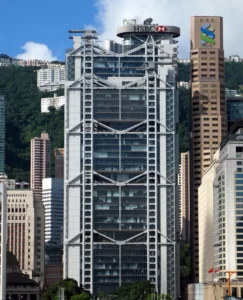
This obsession with technical detail as aesthetic expression characterized Foster’s entire work. His Stansted Airport (1981-1991) near London demonstrated how a utilitarian infrastructure could achieve sculptural grace: a forest of structural steel “trees” supported a translucent roof flooded with zenithal light, creating a space of cathedral serenity for travelers. Later, the Millau Viaduct (1993-2004) in France, with its slender pylons rising to 343 meters, would prove that structural engineering could rival the greatest works of art.
Industrial Design: When Objects Become Sublime Machines
Mario Bellini: Humanizing Technology
In the field of industrial design, Italian Mario Bellini embodied a sophisticated approach to High-Tech that tempered technological coldness with formal sensuality and attention to human experience. Consultant for Olivetti since 1963, Bellini revolutionized office machine design at a time when computers and calculators began invading workspaces. His Divisumma 18 calculator (1972) won the Compasso d’Oro by marking a decisive break with the cold, rectangular aesthetic of office equipment.
Bellini’s genius lay in his ability to sculpt technology: his keyboards were no longer simple functional grids but tactile landscapes where keys became gentle hills, his molded ABS housings organically embraced internal components rather than imprisoning them in rigid boxes. This approach, which dialogued with the principles of organic design, demonstrated that a machine could embrace sensual curves while maintaining its functional rigor. For the Olivetti ET 101 typewriter (1978), he created an elegant wedge profile anticipating laptop computer aesthetics, while the Olivetti Praxis 48 (1981) camouflaged a typewriter’s mechanical complexity under sensual curves in glossy black resin.
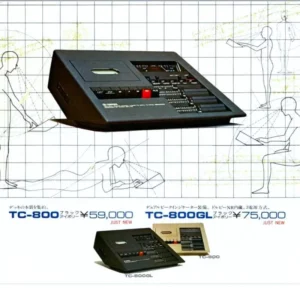
This approach found its apex with his creations for Yamaha: the TC-800 series Hi-Fi systems (1974-1978) transformed domestic electronics into objects of sculptural desire. Amplifiers, tuners and turntables were no longer concealed in wooden furniture but proudly displayed as precision instruments. Brushed aluminum faceplates, analog dials with refined typography, finely knurled control knobs celebrated the intrinsic beauty of audio technology while making it accessible and desirable. Bellini demonstrated that High-Tech didn’t necessarily mean austerity, but could instead combine performance and sensory pleasure.
Richard Sapper: The Silent Intelligence of Objects
If Bellini sculpted technology, German Richard Sapper (1932-2015) refined it to its essence. Trained in Munich then settling in Milan in 1958, Sapper embodied a unique synthesis between Germanic rigor and Italian elegance. His philosophy held in a formula: “Good design is recognized by the intelligence of its functionality.” Each of his objects testified to deep reflection on gesture, use, duration, transforming utilitarian products into instruments of almost surgical precision.
His collaboration with Marco Zanuso produced as early as 1964 the TS 502 portable radio for Brionvega, a cubic ABS housing with rounded corners and integrated handle that broke with the gadget transistor radios of the era. But it was his Tizio lamp (1972) for Artemide that became the absolute icon of domestic High-Tech design. Without visible electrical cable – the current passed through the metal structure itself –, perfectly balanced thanks to invisible counterweights, orientable in all planes with intoxicating mechanical fluidity, Tizio transformed a simple desk lamp into a fascinating kinetic object.
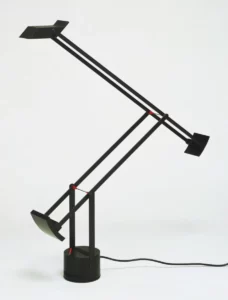
Tizio aesthetics crystallized all High-Tech codes: industrial matte black, visible articulations inspired by robot arms, miniaturized halogen exposing its technology, total absence of ornamentation. It sat equally on architects’ desks and science-fiction film sets, embodying timeless modernity. Its continuous production for over fifty years testified to its unsurpassed formal relevance. For IBM, Sapper designed the ThinkPad (1992), a sober black laptop that became the professional computing standard, proving that his minimalist and functional approach transcended decades.
Dieter Rams and Braun: The Liturgy of Technical Simplicity
Impossible to evoke High-Tech design without mentioning Dieter Rams and his work for Braun. Although his career began in the 1950s, the apex of his influence on technological aesthetics unfolded in the 1970s-1980s. Braun’s design director from 1961 to 1995, Rams developed a philosophy summarized in his famous “10 principles of good design” that became the catechism of industrial design: “Good design is innovative, makes a product useful, is aesthetic, makes a product understandable, is unobtrusive, is honest, is long-lasting, is thorough down to the last detail, is environmentally friendly, and is as little design as possible.”
Braun products under his direction – from the SK 4 phonograph player (1956, nicknamed “Snow White’s Coffin”) to the ET series calculators (1970s-1980s), from electric shavers to Atelier audio systems – defined an aesthetic of maximum reduction: perfect geometric grids, austere Akzidenz-Grotesk typography, chromatic palette limited to black, white and gray, honest materials (metal, glass, quality plastic) without pretense. This approach profoundly influenced contemporary electronic design, up to Jonathan Ive and Apple who openly acknowledged their debt to Rams. Rams’ legacy was part of the continuity of the Good Design Movement which, from the 1940s-1950s, advocated accessibility and quality for all.
The Braun-Rams approach represented the ascetic and almost mystical face of High-Tech: where other designers celebrated technical exuberance, Rams practiced a form of Zen restraint where technology disappeared behind function. His products didn’t seek to impress but to disappear into the obviousness of their utility. This philosophy of “less but better” resonates today with particular acuity facing the overabundance of connected objects and the quest for more sober and sustainable technology.
Materials and Implementation: The Industrial Palette
Steel: Structure and Truth
Metal, and particularly steel, constitutes the emblematic material of High-Tech, celebrated for its exceptional structural properties and raw industrial aesthetic. Movement architects systematically exploited standardized rolled profiles – IPN, HEA, circular and square tubes – from the industrial metal construction catalog. This assumed standardization frontally opposed artisanal tradition: rather than designing custom elements, High-Tech creators composed with standardized dimensions, transforming industrial constraint into formal vocabulary.
Metal finishes became aesthetic language: hot-dip galvanized steel with its random crystallization patterns (spangles), brushed stainless steel with linear reflections, anodized aluminum in its range of grays, steel painted in bright colors coding functions (as at Pompidou). Architects also revealed assembly systems: visible hexagonal-head bolts, polished but visible welds, generously dimensioned connection plates. What was traditionally hidden in wall thickness became the very matter of architectural composition, creating radical structural honesty.
High-strength steel cables and tie-rods allowed spectacular tensile structures inspired by naval and aeronautical engineering. Parc de la Villette in Paris (Bernard Tschumi, 1982-1998) or the Millennium Dome tent in London (Richard Rogers, 1999) exploited these traction systems replacing traditional masonry compression with taut lightness. Steel also enabled large spans without intermediate support, liberating interior spaces: truss beams, gerberette structures, metal arches created entirely open cathedral halls.
Glass: Transparency and Performance
If steel formed High-Tech’s skeleton, glass constituted its skin. The 1970s-1980s saw spectacular advances in glass technology: double glazing improving thermal insulation, tinted and reflective glass controlling solar input, laminated glazing for security, and emergence of the first selective coated glazing letting visible light pass while blocking infrared. These innovations allowed High-Tech architects to realize their dream of total transparency without sacrificing energy performance.
Industrialized curtain wall systems were perfected: aluminum profiles with thermal breaks, EPDM joints ensuring waterproofing, integrated condensation drainage systems. Facades became complex technical skins concealing beneath their apparent simplicity remarkable engineering sophistication. Norman Foster pushed this logic to create double-skin facades: two glass walls separated by a naturally ventilated air gap, creating a thermal chimney effect assisting passive climate control.
Structural glass – assemblies by silicone bonding or mechanical clamps – enabled minimizing or even eliminating visible mullions, creating spectacular continuous translucent walls. Nineteenth-century greenhouses (Paxton, Labrouste) had opened the way; High-Tech extended it with contemporary means. Zenithal skylights, light-bathed atriums, glass walkways suspended between volumes became movement signatures, affirming that architecture could be simultaneously protective and immaterial, technical and poetic.
Composites and Plastics: The Polymer Revolution
If steel and glass anchored High-Tech in heavy industrial tradition, composite and plastic materials opened it toward chemical and aerospace modernity. ABS (Acrylonitrile Butadiene Styrene), polycarbonate, polypropylene and thermosetting resins allowed designers to create forms impossible with traditional materials: one-piece shells without visible joints, tinted transparencies, controlled surface finishes (glossy, matte, textured).
High-Tech furniture massively exploited these possibilities: chairs by Charles and Ray Eames in fiberglass, seating by Verner Panton in one-piece molded polypropylene, office chairs by Herman Miller combining technical mesh and structural polymers. Italian company Kartell, under artistic direction of Anna Castelli Ferrieri then designers like Philippe Starck, made technical plastic a noble material, proving it could aesthetically rival precious wood or leather, participating in the democratization of accessible good design.
Carbon fiber and Kevlar composites, inherited from aeronautics and motor racing, began timidly appearing in 1980s luxury design: ultra-light furniture, prestige vehicle bodies, high-end sports equipment. Their visible textile weave under transparent resin itself became a performance aesthetic code, signaling belonging to the world of cutting-edge technology. This high-performance composite aesthetic prefigured its explosion in automotive and industrial design of the 2000s-2010s.
International Circulation and National Variations
The British Matrix: From Brutalism to High-Tech
While High-Tech was an international movement, Great Britain indisputably constituted its original home. This British preeminence was explained by several converging factors: the heritage of a brilliant structural engineering culture (from Victorian bridges to the Crystal Palace’s metal constructions), a tradition of brutalist architecture assuming material rawness (Smithson, Stirling), and especially a generation trained at London’s Architectural Association in the 1950s-1960s cultivating radical experimentation.
The founding trio – Norman Foster, Richard Rogers, Nicholas Grimshaw – all born in the 1930s, shared similar training and fascination for America’s Buckminster Fuller and his geodesic domes, Charles and Ray Eames and their celebration of intelligent industrialization. Their first projects in the 1960s tested industrialized construction systems: sandwich panels, lightweight metal structures, removable envelopes. The Reliance Controls factory (Team 4, 1967) already prefigured all High-Tech aesthetics with its apparent structure and use flexibility.
International recognition came with major 1970s projects: beyond Pompidou, the Sainsbury Centre for Visual Arts in Norwich (Foster, 1974-1978) refined the concept of “noble hangar” – vast single hall under apparent metal structure and translucent roofing, where contemporary art dialogued with industrial aesthetics. British success was also explained by economic pragmatism: industrialized systems promised execution speed and cost control, decisive arguments during crisis periods. British High-Tech then exported its expertise worldwide, from Hong Kong skyscrapers to Middle Eastern airports.
The Italian Interpretation: Design and Industry
Italy approached High-Tech through a different door: that of industrial design and the intimate relationship between creators and manufacturers that the Italian system had maintained since the postwar period. Companies like Olivetti, Artemide, Kartell, Cassina, B&B Italia or Alias didn’t just produce author designs, they became true research laboratories where engineers and designers closely collaborated to push technical and formal limits.
Adriano Olivetti, tutelary figure who died in 1960 but whose legacy irrigated subsequent decades, had established a unique model: an industrial company massively investing in design, architecture and culture. Under his direction then his successors’, Olivetti simultaneously employed Ettore Sottsass, Mario Bellini, Michele De Lucchi, transforming each typewriter, calculator or computer terminal into an aesthetic manifesto. This approach diffused throughout Italian industrial fabric: Alberto Meda for Alias, Achille Castiglioni for Flos, Vico Magistretti for Artemide created objects where technical sophistication never sacrificed formal elegance.
“Made in Italy” High-Tech distinguished itself by refusing austerity: where the British cultivated quasi-industrial rawness and Germans Spartan rigor, Italians injected sensuality, color and audacity. The Seconda chair (1982) by Mario Botta for Alias, with its perforated tubular steel structure in lacquered steel, or the Titania lamp (1989) by Alberto Meda and Paolo Rizzatto for Luceplan, with its micro-cast aluminum reflector of extreme fineness, demonstrated that one could be technologically radical while remaining seductive. This Italian path would profoundly influence consumer electronics design of the 1990s-2000s.
American and Japanese Metamorphoses
In the United States, High-Tech found fertile ground in Californian culture of technological innovation and entrepreneurial informality. The nascent Silicon Valley of the 1970s, with its garages transformed into startups and relaxed industrial campuses, naturally adopted an aesthetic celebrating technology without formal hierarchy. Architects like Helmut Jahn adapted High-Tech vocabulary to the monumental scale of Chicago skyscrapers, while on the West Coast, firms like Morphosis (Thom Mayne) fused High-Tech and deconstruction.
American industrial design, embodied by companies like Herman Miller (office furniture), Apple (consumer computing) or IBM (professional computing), developed a High-Tech approach focused on ergonomics and user experience. The Aeron office chair (1994) by Don Chadwick and Bill Stumpf for Herman Miller, with its stretched mesh and sophisticated fully visible adjustment mechanism, became the icon of High-Tech office furniture, equipping trendy advertising agencies and Wall Street trading rooms alike.
Japan, for its part, interpreted High-Tech through the prism of its culture of manufacturing excellence and its aesthetic of perfect detail. Sony, with its Walkman (1979) designed under Norio Ohga‘s direction, miniaturized audio technology until making it portable and personal, creating a cult object whose metal casing, tactile buttons and impeccable finishes defined a new category of nomadic products. Canon, Nikon and Minolta applied the same care to SLR cameras, transforming photographic electronics into precision jewelry. This Japanese obsession with perfect miniaturization and manufacturing quality prefigured the aesthetics of contemporary smartphones and connected objects.
Cultural Impact: From Film Set to Street
Science Fiction and Collective Imagination
The High-Tech movement maintained a fascinating symbiotic relationship with science fiction, particularly cinematic. Ridley Scott‘s sets for Alien (1979) and Blade Runner (1982), imagined by Ron Cobb and Syd Mead, massively borrowed from High-Tech vocabulary: metal walkways, visible piping, converted industrial structures, technical lighting. This “used future” aesthetic where technology was no longer gleaming but weathered, functional rather than spectacular, resonated deeply with the High-Tech architectural approach.
Inversely, High-Tech architecture and design fed science-fiction imagination: Centre Pompidou appeared in futuristic films, High-Tech interiors equipped Star Trek spaceships, Italian design furniture furnished James Bond villains’ headquarters. This circularity between real and fiction installed High-Tech as the visual language of technological modernity, influencing film set designers as well as interior architects, industrial designers as video game illustrators.
Emerging 1980s video games, with their pixelated aesthetics and minimalist interfaces, shared with High-Tech a fascination for functional legibility and economy of means. Atari, Commodore or Nintendo consoles adopted housings with technological lines, colored buttons and mechanical typography inscribing them in the High-Tech aesthetic family. This convergence prefigured the importance of interface design and user experience in the contemporary digital economy.
Loft Culture and Industrial Conversion
High-Tech architecture coincided with the emergence of loft culture in Western metropolises, particularly in New York, London and Paris. Artists, then young professionals, invested disused former industrial spaces – factories, warehouses, workshops – attracted by their vast volumes, high ceilings and luminosity. These initially illegal then progressively legalized squats naturally adopted an aesthetic that valorized rather than hid industrial heritage: exposed bricks, metal beams, visible ventilation ducts, polished concrete floors.
This rehabilitation of industrial into chic residential consecrated High-Tech aesthetics as a marker of social distinction. 1980s decoration magazines (Wallpaper, Elle Décoration, AD) celebrated these interiors where design furniture coexisted with industrial vestiges, where a Tizio lamp illuminated a desk set on metal trestles, where Tecno shelves stored art books and rare vinyl. The loft became the typical setting of the new creative class – graphic designers, architects, advertisers, artists – who valued industrial authenticity over traditional bourgeois comfort.
Paradoxically, this aestheticizing gentrification of industrial neighborhoods participated in their socio-economic transformation and progressive eviction of productive activities and original working-class populations. High-Tech, a movement celebrating industry, thus accompanied its disappearance from central urban fabric. SoHo in New York, Shoreditch in London, Belleville in Paris passed in two decades from the status of industrial wastelands to trendy neighborhoods where rents now excluded pioneering artists. This tension between aesthetic celebration and economic reality traversed the entire movement’s history.
Fashion and Clothing Culture
High-Tech’s influence transcended architecture and object design to irrigate fashion and clothing culture. From the late 1970s, creators explored technical materials: ripstop nylon, Gore-Tex, neoprene, reflective fabrics borrowed from industrial work clothing and performance sports equipment. Issey Miyake in Japan, Jean-Paul Gaultier in France incorporated industrial zippers, straps, clips and metal buckles into their collections.
The 1980s saw the explosion of sportswear and streetwear that democratized this technical aesthetic: Nike sneakers with their visible air cushions and apparent reinforced structures, Patagonia and The North Face jackets in bright colors with multiple technical pockets, Casio multifunction digital watches became accessories of relaxed modernity. The “techwear” look that would emerge in the 2000s (Acronym, Stone Island) would extend and radicalize this fusion between technical functionality and stylistic expression.
More conceptually, High-Tech influenced the very approach to clothing: rather than decorative envelope concealing the body, it became adaptable technical system – removable linings, detachable hoods, transformable pockets. This modularity, directly inspired by High-Tech architecture and its reconfigurable spaces, anticipated contemporary questioning about clothing sustainability and wardrobe multi-functionality.
Furniture and Iconic High-Tech Design Objects
Beyond monumental architecture and sophisticated office machines, the High-Tech movement thus produced a constellation of domestic objects and furniture that profoundly marked contemporary material culture. These creations translated to the scale of habitat and daily life the principles developed in grand edifices: apparent structure, assumed industrial materials, functional modularity and celebration of technique as aesthetic language.
Modular Shelving Systems: Kit Architecture
The USM Haller Shelf (1965), Designed by Fritz Haller
The USM Haller shelf (1965), designed by Fritz Haller for Swiss company USM, perfectly embodied High-Tech philosophy applied to furniture. Initially developed as an industrial shelving system for archives and warehouses, it consisted of standardized elements assemblable infinitely: chrome tubes, connection spheres and lacquered metal panels. Its genius lay in its universal constructive logic – each owner became architect of their own storage system, adding, removing or reconfiguring modules according to evolving needs.
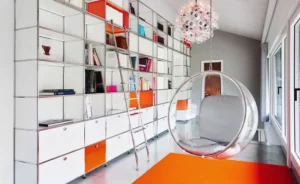
This radical modularity directly responded to Cedric Price and Archigram’s precepts: furniture was no longer a fixed object but an evolving system. The chrome spheres at joints, far from being concealed, became the system’s visual signature, transforming a technical element into ornament. Adopted by major companies (IBM, Apple) as well as trendy individuals, USM traversed decades without aging, its color palette regularly enriching (from immaculate white to Klein blue) while maintaining its industrial DNA.
606 Universal Shelving System (1960) by Dieter Rams
In the same spirit, the 606 Universal Shelving System (1960) by Dieter Rams for Vitsœ applied rigorous German design principles to modular wall furniture. Metal uprights fixed to the wall, interchangeable wood or metal shelves, cabinets and drawers composed a minimal vocabulary allowing infinite configurations.

Unlike USM’s more industrial character, the 606 privileged refined discretion where structure disappeared behind function. Produced continuously for over sixty years with the same standardized dimensions, guaranteeing compatibility between new and old pieces, it embodied the High-Tech ideal of durability through modularity.
Technical Seating: Ergonomics as Sculpture
If the High-Tech movement celebrated the machine, it didn’t forget the human body inhabiting it.
The Nomos Armchair (1986) by Norman Foster
Norman Foster’s Nomos armchair for Tecno materialized this concern: polished aluminum structure like an aeronautical chassis, sophisticated fully visible rocking mechanism, leather stretched over metal frame recalling Eames seats but pushing technical legibility further. Every rivet, every articulation participated in formal composition, transforming a simple office chair into a precious mechanical object.
The Seconda Chair (1982) by Mario Botta
Mario Botta’s Seconda chair for Alias radicalized this approach: tubular steel structure perforated with regular holes – initially functional to lighten weight, become decorative motif –, seat and back composed of the same folded and perforated sheet metal. The result evoked simultaneously construction scaffolding and sophisticated garden furniture, an ambiguity typically High-Tech where industrial became refinement. Versions lacquered in bright colors (red, yellow, blue) accentuated this joyful celebration of steel sheet, humble material elevated to art.
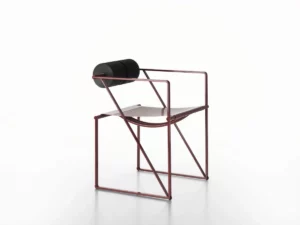
The Louis 20 Armchair (1992) by Philippe Starck, Vitra
The Louis 20 armchair (1992) by Philippe Starck for Vitra pushed logic to provocation: tubular legs in anodized aluminum, one-piece molded polypropylene seat, openwork backrest in synthetic mesh. Starck subverted Louis XVI armchair codes – hence the ironic name – translating them into a resolutely industrial vocabulary. The contrast between aristocratic historical reference and popular plastic materiality created conceptual tension characteristic of late High-Tech, more playful and postmodern than its pioneering incarnations.

Lighting: Light as Visible Mechanism
Beyond the mythical Tizio by Sapper already mentioned, High-Tech produced a remarkable family of luminaires celebrating their technicality.
Atollo (1977) by Vico Magistretti for Oluce
The Atollo lamp by Vico Magistretti for Oluce, though more classical in its geometric proportions, used turned and anodized aluminum affirming its industrial nature. Its form – cylinder, cone, stacked hemisphere – evoked Platonic solids while remaining faithful to metallurgical manufacturing processes.
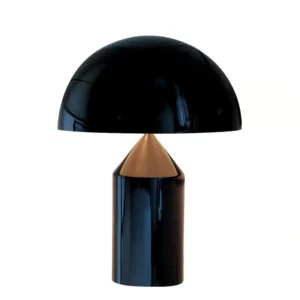
The 265 Series (1973) by Paolo Rizzatto for Flos
The 265 series by Paolo Rizzatto for Flos, with its telescopic articulated arms in chrome steel and visible counterweights, transformed a wall sconce into a kinetic machine. The user didn’t just turn on or off: they physically manipulated the object, deployed its segments, oriented the light beam, engaged tactile dialogue with the mechanism. This mechanical interactivity, where each gesture revealed internal functioning, anticipated contemporary physical interfaces.
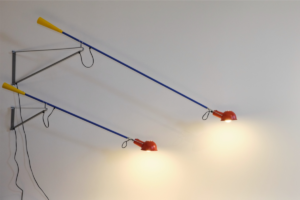
The Noce T/2 System (1972) by Achille and Pier Giacomo Castiglioni for Flos
The Noce T/2 system by Achille and Pier Giacomo Castiglioni for Flos radicalized the approach: a simple black bakelite transformer from which emerged a naked halogen bulb, suspended by its textile electrical cable. No lampshade, no casing, just raw technical truth. This radical asceticism, which initially shocked the public, became a signature of industrial modernity, infinitely copied in trendy bars and restaurants seeking “authentic” aesthetics.
Domestic Accessories: When Tool Becomes Icon
The High-Tech movement wasn’t limited to major furniture pieces, but irrigated all daily objects. The G-Shock (1983) watch by Kikuo Ibe for Casio transposed industrial aesthetics to the wrist: reinforced resin case capable of resisting the most violent shocks, readable digital display, multiple functions (chronograph, alarms, backlight) displayed without flourish. Initially designed for construction sites and armed forces, the G-Shock became a cult object of urban culture, worn by construction workers and hip-hop musicians alike, embodying High-Tech democratization.
Alessi kitchen utensils under Alessandro Mendini’s artistic direction, though sometimes more postmodern than strictly High-Tech, integrated this celebration of technical performance. The 9093 kettle (1985) by Michael Graves, with its bird-shaped whistle on a shiny stainless steel conical body, or the Juicy Salif citrus press (1990) by Philippe Starck, arachnid sculpture in polished aluminum more art object than functional juicer, demonstrated that even culinary accessories could become formal manifestos.
Casio and Texas Instruments scientific calculators, with their membrane rubber keyboards, resistant ABS housings, LCD displays with angular characters, constituted a family of democratized High-Tech objects, accessible to all high school and college students. Their rigorously functional interfaces – each key clearly identified, visual hierarchy of functions, robustness adapted to intensive use – applied Dieter Rams’ precepts to consumer electronics, durably influencing contemporary touch interface design.
Watchmaking and Mechanical Precision
If the G-Shock watch embodied robust and democratic High-Tech, Swiss luxury watchmaking developed a sophisticated interpretation of the movement. Richard Mille watches, appearing in the 2000s but direct heirs of High-Tech aesthetics, proudly exposed their complex mechanical movements through transparent sapphire cases or technical composites borrowed from Formula 1. Skeletonized bridges, visible titanium screws, visible gears transformed the watch into micro mechanical architecture worn on the wrist.
Professional diving watches Rolex Submariner, Omega Seamaster or Blancpain Fifty Fathoms, though predating strict High-Tech movement, shared its spirit: technical tool displaying its function without complex. Rotating graduated bezel, oversized screw-down crown, massive phosphorescent hands, applied indexes in relief – each element responded to functional necessity while composing coherent aesthetics. These watches influenced the design of all High-Tech measurement and instrumentation objects.
In a more accessible register, Swatch watches (1983), revolution of Swiss watchmaking facing the quartz crisis, applied High-Tech principles to mass production: one-piece molded plastic case containing an ultra-simplified 51-component movement (versus 90 to 150 for a traditional mechanical watch), automated assembly, minimalist design. This radical rationalization of the production process, celebrating industrial efficiency rather than traditional craftsmanship, saved Swiss watchmaking by projecting it into the High-Tech era.
Heritage in Contemporary Design
These iconic objects established a formal repertoire that continues influencing contemporary design. Industrial metal shelves furnish New York lofts as well as Parisian studios, articulated arm lamps illuminate global coworking spaces, technical watches adorn successive generations of urban professionals’ wrists. This durability testified to the correctness of High-Tech intuition: the beauty of well-fulfilled function transcends passing fashions.
High-Tech furniture also anticipated contemporary concerns of sustainability and modularity. In the age of circular economy and responsible design, the capacity of USM or Vitsœ systems to evolve with needs without being entirely replaced, their repairability (each component available separately), their formal timelessness escaping aesthetic obsolescence constitute rediscovered virtues. High-Tech, a movement celebrating technology, paradoxically demonstrated that a rigorous technical approach could produce more durable objects than often-idealized traditional craftsmanship.
These creations finally democratized a certain form of technical sophistication: wearing a G-Shock or using a Casio scientific calculator required neither fortune nor expert knowledge, unlike traditional luxury objects. This High-Tech accessibility, its capacity to transform cutting-edge technologies into affordable mass-market products, joined Good Design Movement ideals and prefigured the digital revolution that would put powerful computers in every pocket. The legacy of High-Tech objects resided as much in their iconic forms as in their promise of technical modernity accessible to all.
Heritage and Posterity: From High-Tech to Digital Design
The Personal Computing Revolution
If 1970s High-Tech celebrated major infrastructures (power plants, airports, corporate headquarters), the 1980s saw the emergence of personal computing transposing this aesthetic to domestic scale. The Apple II (1977) by Steve Wozniak and Steve Jobs, in its functional beige case, then especially the Macintosh (1984) designed under Jobs’ supervision with the Frog Design team, established a new paradigm: complex technology could be visually simple, intuitive and even warm.
This “humanized High-Tech” approach found its apex in Apple creations under Jonathan Ive‘s design direction from 1996: the iMac G3 (1998) with its translucent colored polycarbonate case exposing internal components, the iPod (2001) reducing an MP3 player to essentials – click wheel and minimalist screen –, the iPhone (2007) eliminating physical buttons and keyboards in favor of an all-screen interface. Ive explicitly acknowledged his debt to Dieter Rams and rigorous German design, while adding tactile sensuality and attention to assembly details recalling the Italian approach.
Contemporary computer design – streamlined interfaces, clear information architecture, sans-serif typography, minimalist icons – directly inherited High-Tech principles: functional legibility, honesty of (digital) materials, celebration of technical performance. Visual metaphors of skeuomorphism (interfaces imitating real objects) progressively gave way to flat design and material design assuming the digital nature of the medium, exactly as High-Tech assumed the industrial nature of its materials.
Contemporary Architecture: Neo High-Tech and Evolutions
High-Tech vocabulary continues evolving and renewing in 21st-century architecture. Norman Foster with his 30 St Mary Axe skyscraper in London (2003, nicknamed “The Gherkin”), Renzo Piano with The Shard (2012) or his Centre Pompidou-Metz (2010), Richard Rogers with Terminal 4 at Barajas in Madrid (2006) demonstrated that structural and technical approach could integrate contemporary stakes of environmental performance and sustainability.
New materials – integrated photovoltaic panels, electrochromic glazing modifying their opacity according to sunlight, high-performance laminated timber structures, ultra-high-performance fiber-reinforced concretes – enriched the High-Tech palette while responding to climate emergencies. The aesthetic remained that of system legibility: solar panels weren’t concealed but integrated into composition, water recovery or natural ventilation systems became expressive architectural elements, prefiguring smart homes where technology and habitat fuse harmoniously.
Architects of the next generation – Shigeru Ban with his cardboard and bamboo structures, Thomas Heatherwick and his sophisticated mechanical compositions, Bjarke Ingels (BIG) fusing High-Tech and organic forms – extended and hybridized High-Tech heritage with new concerns. Zaha Hadid‘s London Aquatics Centre (2011) or the Heydar Aliyev Center in Baku (2012) demonstrated how digital design and fabrication tools enabled creating structures of geometric complexity unimaginable in the 1970s, while maintaining the High-Tech spirit of technical celebration and structural prowess.
Critiques and Limits: High-Tech’s Blind Spots
Despite its considerable influence, the High-Tech movement didn’t escape substantial critiques. The main concerned its energy balance: vast glazed surfaces, despite technological progress, generated significant thermal losses in winter and overheating in summer, requiring energy-intensive climate control systems. Lloyd’s Building thus consumed four times more energy per square meter than a conventional British office building. This contradiction between performance aesthetics and actual performance became embarrassing in the age of climate emergency.
Urbanistically, High-Tech architecture was accused of lacking contextualism and dialogue with historic fabric. Its large metal and glass structures, thought as autonomous objects, often created brutal ruptures in urban landscape. Centre Pompidou, despite its public success, remained a “UFO” in the medieval Marais; City of London High-Tech skyscrapers crushed surrounding Wren baroque churches. This formal arrogance, assumed in the 1970s as necessary provocation, appeared more problematic today facing contemporary approaches privileging harmonious integration with environment and dialogue between built and nature.
Socially, High-Tech was criticized for its economic and cultural elitism. High-performance materials, sophisticated assembly details, complex technical systems required considerable budgets and expert maintenance, de facto reserving this architecture for major institutions, multinational companies and wealthy clientele. Attempts to apply High-Tech to social housing often resulted in failures: technical systems degraded rapidly without appropriate maintenance, industrial materials aged poorly, creating inhospitable environments.
Philosophically, the movement was accused of naive techno-optimism, celebrating technology without questioning its social, political or environmental implications. This blind faith in technical progress as universal solution appeared dated in a context where industrialization’s perverse effects – pollution, resource depletion, climate change – imposed a more critical and nuanced approach to the relationship between humanity and technology.
Contemporary Perspectives: Toward Sustainable High-Tech?
Adaptation to Environmental Stakes
Facing energy critiques, first-generation High-Tech architects evolved toward what could be called “green High-Tech” or “eco-High-Tech”. Norman Foster became a pioneer of environmental architecture with projects like the renovated Reichstag in Berlin (1999), whose glass dome integrated natural ventilation system and solar panels, or Hearst Tower in New York (2006), first LEED Gold certified skyscraper.
This evolution didn’t deny High-Tech principles – apparent structure, technical celebration, industrial materials – but put them in service of environmental performance. Natural ventilation systems, heat recovery, photovoltaic panels, green roofs, far from being concealed, became new expressive elements of architectural composition. The building transformed into environmental machine whose all organs remained legible, an approach resonating with contemporary principles of biophilic architecture seeking to reconcile technology and nature in harmonious synthesis.
Concepts like active facades – dynamic walls adapting to climatic conditions thanks to sensors and actuators – or high-tech bioclimatic architecture – combining vernacular knowledge and cutting-edge technologies – traced paths of High-Tech reconciled with planetary constraints. Council House 2 in Melbourne (DesignInc, 2006) or Al Bahar towers in Abu Dhabi (Aedas, 2012) with their mechanized mashrabiyas were remarkable examples.
Digital Heritage and Advanced Manufacturing
High-Tech vocabulary found natural extension in digital fabrication and parametric design technologies. 3D modeling software, generative algorithms, structural and thermal simulation tools enabled designing structures of unprecedented complexity while optimizing their performance. Robotic fabrication systems, large-scale 3D printing and laser cutting authorized realization of previously impossible geometries.
This convergence between historical High-Tech and digital revolution gave birth to what some theorists called “Digital Craft”: an approach where computational sophistication and robotic precision created new forms of technical virtuosity. Experimental pavilions of Stuttgart’s Institute for Computational Design (ICD), robotically wound carbon fiber structures, algorithmically optimized complex assemblies constituted the new frontier of High-Tech design.
In industrial design, metal 3D printing and advanced composite materials enabled creating objects combining extreme lightness and high structural resistance, realizing the High-Tech dream of maximum optimization. Personalized medical prosthetics, topologically optimized aerospace components, generatively designed automotive parts embodied this new High-Tech generation where algorithmic intelligence joined manufacturing precision.
Influence on Experience and Interface Design
Beyond physical objects, the High-Tech approach profoundly influenced interface design and digital experience design. Principles of functional legibility, system honesty and performance celebration irrigated the design of contemporary applications, websites and digital services. “Flat design” interfaces popularized by Apple iOS 7 (2013) and Google Material Design (2014) applied to digital the lessons of analog High-Tech: typographic clarity, rigorous information hierarchy, animations revealing functioning rather than decorating it.
The visual vocabulary of aeronautical HUD (Head-Up Display) – monospace typography, reading grids, functional color codes – migrated toward consumer interfaces, from automotive dashboards to fitness applications. This “technical” aesthetic reassured users by giving them the impression of understanding and controlling complex systems, exactly as High-Tech architecture reassured by making building infrastructure visible.
Connected objects and the Internet of Things extended the High-Tech idea of integrated and communicating technical systems. Smartwatches, intelligent thermostats, voice assistants exposed (digitally) their data and processes, transforming our domestic environments into legible and controllable technical ecosystems. This High-Tech home automation realized forty years later the 1970s fantasies of technologically assisted “intelligent house,” as explored by contemporary residences integrating advanced home automation and intelligent systems.
High-Tech Style: The Persistence of a Vision
More than fifty years after its first built manifestos, the High-Tech movement appeared as one of the most influential and durable currents in contemporary design history. Its capacity to celebrate technology without fetishizing it, to reveal structures without falling into simplism, to combine technical performance and aesthetic expression made it a formal vocabulary of exceptional richness. The principles it established – structural honesty, modularity, adaptability, industry celebration – remained surprisingly relevant facing contemporary challenges.
High-Tech heritage far transcended architecture and object design to permeate our collective visual culture. From digital interfaces to technical clothing, from coworking spaces to trendy coffee shops proudly exposing their visible piping, sophisticated industrial aesthetics became the default visual language of technological modernity. This massive diffusion testified to the intuitive correctness of the High-Tech project: in an age saturated with technology, it’s more honest and satisfying to celebrate it openly rather than hypocritically conceal it.
Current environmental challenges however imposed critical reevaluation of certain movement aspects. 21st-century High-Tech could no longer be satisfied with structural performance: it must integrate energy performance, circular economy, material sobriety. Movement pioneers, far from freezing in nostalgia, moreover undertook this evolution, demonstrating that High-Tech principles – optimization, efficiency, systemic intelligence – could serve ecological transition rather than contradict it.
Finally, High-Tech reminded us of an essential truth: technology is neither good nor bad in itself, but the intelligence and sensitivity with which we conceive, deploy and integrate it into our lives determines its value. By transforming factory into cathedral, bolt into ornament, structure into sculpture, High-Tech creators demonstrated it was possible to reconcile technical efficiency and formal beauty, industrial rationality and aesthetic emotion. This lesson remained burning current at a time when we must entirely rethink our relationship with the tools, machines and technical systems shaping our daily existences.

Digital entrepreneur and craft artisan, I use my unconventional background to share my vision of luxury design and interior decoration — one enriched by craftsmanship, history, and contemporary creation. Since 2012, I have been working daily in my workshop on the shores of Lake Annecy, creating bespoke interiors for discerning decorators and private clients.



